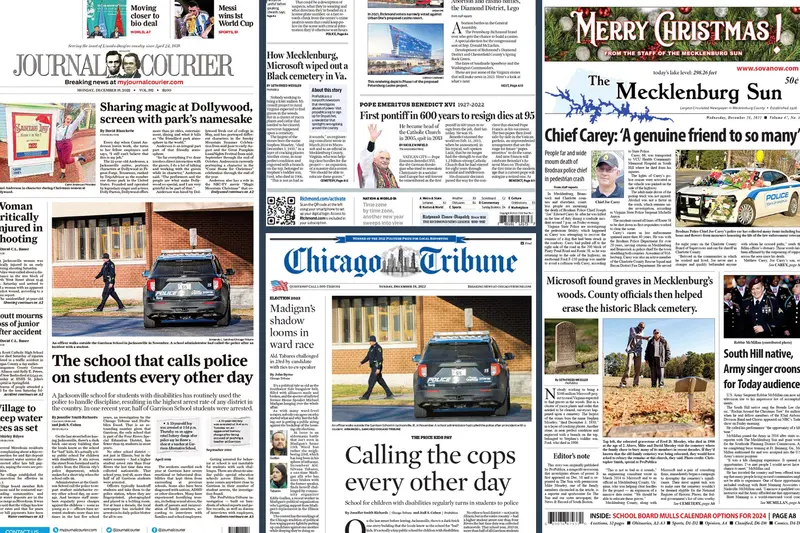The 2-Minute Rule for News Articles
The 2-Minute Rule for News Articles
Blog Article
10 Simple Techniques For News Articles
Table of ContentsNews Articles - The FactsSome Known Incorrect Statements About News Articles The Ultimate Guide To News ArticlesThe Only Guide to News ArticlesFascination About News Articles
Great expertise of different subjects gives trainees an one-upmanship over their peers. Although digital and social media are easily easily accessible, we ought to not forget how vital it is to review the newspapers. Moms and dads need to try and inculcate the behavior of reading a paper as a daily routine to proceed the legacy of the adored print tool.News tales likewise have at the very least one of the adhering to important features relative to the designated audience: proximity, importance, timeliness, human passion, anomaly, or repercussion.
Within these restrictions, information tales additionally aim to be thorough. Among the bigger and extra reputable newspapers, justness and balance is a major aspect in presenting information.
Papers with a global target market, for instance, tend to use a more official style of creating. The details options made by an information electrical outlet's editor or editorial board are frequently collected in a design guide; typical design overviews include the and the United States Information Style Book. The primary goals of information writing can be summed up by the ABCs of journalism: accuracy, brevity, and quality.
Some Known Details About News Articles
As a rule, journalists will certainly not make use of a long word when a short one will do. They make use of subject-verb-object building and dazzling, active prose (see Grammar). They use stories, examples and allegories, and they hardly ever depend on generalizations or abstract ideas. Information writers attempt to stay clear of making use of the same word more than once in a paragraph (often called an "resemble" or "word mirror").
Headlines sometimes leave out the topic (e.g., "Jumps From Boat, Catches in Wheel") or verb (e.g., "Cat female lucky"). A subhead (additionally subhed, sub-headline, subheading, caption, deck or dek) can be either a secondary title under the main heading, or the heading of a subsection of the post. It is a heading that comes before the primary message, or a group of paragraphs of the main message.

Added signboards of any of these types may appear later in the post (especially on subsequent web pages) to tempt additional reading. Such signboards are also made use of as guidelines to the short article in various other sections of the publication or website, or as advertisements for the item in other publication or sites. Normal framework with title, lead paragraph (summary in vibrant), More hints other paragraphs (information) and get in touch with information.

Instance of a hard-lead paragraph NASA is suggesting an additional space task. The budget requests approximately $10 billion for the task.
An "off-lead" is the 2nd most important front web page information of the day. To "bury the lead" is to start the short article with history info or details of additional significance to the readers, requiring them to read more deeply into an article than they should have to in order to find the crucial points.
Rumored Buzz on News Articles
Typical use is that a person or 2 sentences each form their very own paragraph. Reporters normally explain the organization or structure of a over at this website newspaper article as an inverted pyramid. The crucial and most interesting components of a story are placed at the start, with sustaining info following in order of lessening significance.
It allows individuals to discover a topic to only the depth that their curiosity takes them, and without the charge of details or subtleties that they could think about unnecessary, but still making that details readily available to much more interested readers. The upside down pyramid framework likewise makes it possible for posts to be cut to any type of approximate size during layout, to fit in the room readily available.
Some authors start their tales with the "1-2-3 lead", yet there are lots of sort of lead offered. This layout usually begins with a "5 Ws" opening up paragraph (as defined over), complied with by an indirect quote that offers to sustain a major component of the initial paragraph, and then a direct quote to support the indirect quote. [] A kicker can describe several things: The last tale in the news program; a "pleased" story to end the show.
Longer short articles, such as magazine cover posts and the items that lead the within areas of a paper, are known as. Function tales vary from straight information in a number of means.
The Only Guide for News Articles
A feature's initial paragraphs typically associate an interesting moment or event, as in an "unscientific lead". From the details of an individual or episode, its sight rapidly expands to abstract principles about the story's topic.

The Editor's Toolbox: A Recommendation Overview for Beginners and Professionals (2001) Allan M. Siegal and William G. Connolly. The New York Times Guidebook of Design and Use: The Official Style Overview Utilized by the Writers and Editors of the Globe's Many Authoritative Newspaper (2002) M. click L. Stein, Susan Paterno, and R.
Report this page